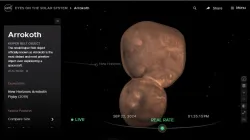Discovery suggests 2nd Kuiper Belt in our solar system: Everything you need to know
Astronomers have uncovered evidence of a potential second Kuiper Belt, expanding the boundaries of our solar system. Here's what this discovery could mean.

Astronomers have discovered evidence suggesting the existence of a second Kuiper Belt, potentially extending the known boundaries of our solar system. This groundbreaking find could significantly reshape our understanding of the solar system’s outer regions and offer new insights into its formation and structure.
What is the Kuiper Belt?
The Kuiper Belt is a vast region beyond Neptune, spanning from about 33 to 55 astronomical units (AU) from the sun. It is filled with icy bodies, dwarf planets, and comets that orbit in the outer reaches of our solar system. This region gained fame after NASA’s New Horizons mission explored Pluto, the most well-known object in the Kuiper Belt, in 2015.
New Objects Discovered Beyond the Kuiper Belt
Recent findings suggest that the solar system could be even larger than previously believed. Using the powerful Subaru telescope’s Hyper Suprime-Cam (HSC), astronomers have identified 239 Kuiper Belt objects since 2020. Among these are 11 objects located between 70 and 90 AU from the sun—far beyond the traditional Kuiper Belt—which indicates the presence of a second, more distant belt, tentatively named "Kuiper Belt 2."
This potential second belt could extend as far as 13.5 billion kilometers (8.4 billion miles) from the sun, marking a significant expansion of our known solar system. Interestingly, there is a gap between 55 and 70 AU, where no objects have been found, which further supports the idea of a distinct second belt.
Implications for Our Understanding of the Solar System
The discovery of Kuiper Belt 2 could dramatically change how we understand the formation of the solar system. For years, scientists have puzzled over the relatively small size of the Kuiper Belt compared to similar belts in other planetary systems. The presence of a second belt suggests that the solar system’s primordial nebula may have been much larger than previously thought.
This finding also raises exciting possibilities about the existence of more dwarf planets and even the elusive Planet Nine, which has been theorized but not yet observed. As astronomers continue to study these distant objects, we may uncover even more mysteries hiding in the outer reaches of our solar system.
Looking Ahead: A New Era of Discovery
The potential discovery of Kuiper Belt 2 opens up new avenues for exploration and could reshape our understanding of the solar system’s outermost regions. With further observation, astronomers hope to learn more about these distant objects and what they reveal about the history and evolution of the solar system.
ALSO READ: New to BSNL 4G? These first recharge plans might help you to save money and deliver maximum benefits
ALSO READ: BSNL 5G testing starts: Could be a game-changer in the Indian telecom sector